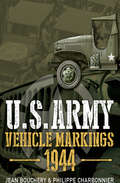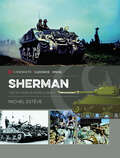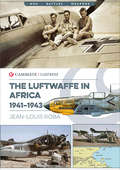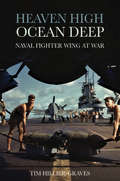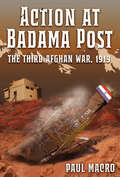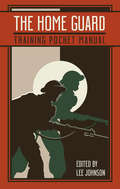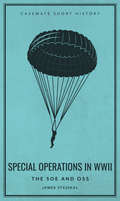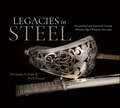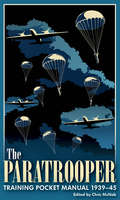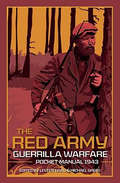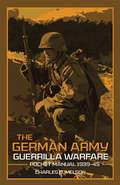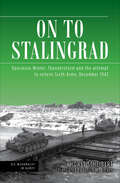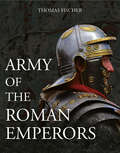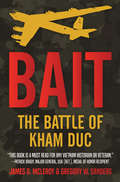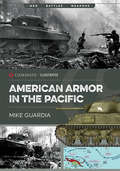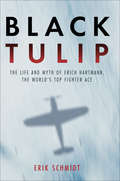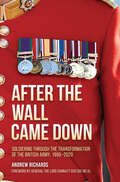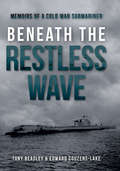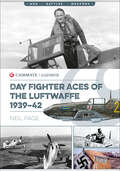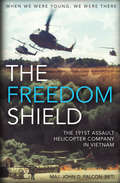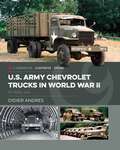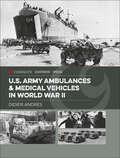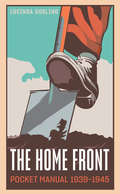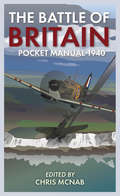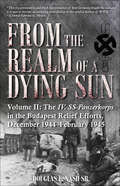- Table View
- List View
U.S. Army Vehicle Markings, 1944
by Jean Bouchery Philippe CharbonnierAn illustrated guide to the markings used on WWII Era U.S. Army tanks, lorries and Jeeps—an invaluable reference for historians, modelers and collectors. The markings of a 1944 U.S. Army Jeep are an iconic image of American military and the Second World War. But few people know what the distinctive white letters, numbers and symbols actually mean. This uniquely detailed guide explains how these and other markings were integral to organizing the U.S. Army on the move. U.S. Army Vehicle Markings 1944 covers all the markings used on American military vehicles to denote their unit and classification. It also covers tactical markings and the debarkation codes used in the Normandy landings. Hundreds of contemporary photographs are paired with precise color diagrams to show exactly how markings appeared on vehicles, including the exact measurements. The volume explains all the variations in the use of these markings and includes a chapter on the varieties of camouflage used on vehicles.
Sherman: The M4 Tank in World War II (Casemate Illustrated Special)
by Michel Esteve“A superbly organized, well-written, detailed history of the Sherman tank” with hundreds of photos and diagrams included (Armor Magazine).The Medium Tank, M4, better known to the British as the Sherman, was the most widely used medium tank by the United States and western Allies in World War II. Reliable, relatively cheap to produce, and easy to maintain, thousands were distributed to the British Commonwealth and the Soviet Union by the Lend-Lease program. It first saw combat in North Africa, where it outclassed lighter German and Italian tanks. By 1944 the M4 was outgunned by the German heavy tanks, but it still contributed to the fight when deployed in numbers and supported by artillery and fighter-bombers.A detailed insight into the development and deployment of the M4, this book covers the design and construction of the chassis, turret, engine, armaments, and munitions, and differences between the variants of the M4. It covers the difficulties facing the crews who fought in this legendary tank, exploring the training they received and the different combat methods perfected by the Allies, including landing from a landing craft, maneuvering in the bocage of Normandy, and fighting in the snow.Fully illustrated with hundreds of contemporary and modern photographs and detailed diagrams, this complete account provides all the technical details of the construction of the M4, its maintenance and repair, and the logistics required to support it in combat.Whether you are a collector, a modeler, or simply passionate about military history, this book will provide you with an unparalleled insight into the M4.“Period photos, preservation shots, interior details, variant schematics, archival excerpts, armament and ammunition drawings, and more . . . Make it your introduction to this legendary tank family.” —Cybermodeler
Luftwaffe in Africa, 1941–1943 (Casemate Illustrated #Cis0015)
by Jean-Louis RobaThis WWII history examines Nazi air force operations in Egypt and Libya with more than 100 rare wartime photographs. When Mussolini&’s army was defeated on the Libyan-Egyptian border at the beginning of 1941, Adolph Hitler had no choice but to send reinforcements to help his ally. The Luftwaffe deployed an air detachment, first to Sicily, then to North Africa. This volume examines the small expeditionary force, solely devoted to protecting Italian possessions in the Mediterranean and Middle Eastern theater. When General Erwin Rommel launched his Afrika Korps to the east, the Luftwaffe had to go on the offensive to cover the advance. As British air forces were strengthened, German High Command was obliged to send more aerial units into what it had initially considered a peripheral arena of the war. Losses in bombers and fighters were high on both sides. By the time the Allies landed in Morocco and Algeria at the end of 1942, the Wehrmacht&’s fate was sealed. The last German units capitulated in Tunisia in May 1943.
Heaven High, Ocean Deep: Naval Fighter Wing at War
by Tim Hillier-GravesIn 1944, with the invasion of Europe underway and battles in the Atlantic and Mediterranean all but won, the Royal Navy`s strength could be focussed on the Far East and the Pacific where the Japanese were still a long way from defeat. Since the Battle of Midway, in June 1942, the United States had been slowly forcing the Japanese back, but it was a long, bloody process. The Allies needed to combine their forces more effectively if they were to bring the war to an end quickly. In response the Royal Navy massed its ships to add weight to the US Navy. With an attack force of four fleet carriers, and two more on the way, the RN`s role would be significant, but would take time to work up to the state of preparedness of their American cousins. And so a fleet was born for use in the Indian Ocean and, later, the Pacific. From April 1944 to August 1945 they would successfully fight many long, intensive battles. In this time each carrier would contribute greatly to victory, none more so than HMS Indomitable with her 5th Fighter Wing. They would be in thick of the fighting, achieve success and live perilously for a prolonged period, losing many men along the way. It was a war of attrition, which allowed little room for compassion or benevolence. The story told in this book is about the exceptional group of young men, from Britain, Canada, New Zealand, Holland and South Africa who joined the Fleet Air Arm as pilots. With their American-built Hellcats they were in the thick of the action, providing a hard, professional core to this fighting fleet that few would equal. Although its operational history is second to none, this was only achieved by the sacrifice and endurance of the men who flew many dangerous missions and daily lived with the spectre of a searing death. And so the book is about them, with war providing a back drop that broods and eviscerates in turn. How did these men come to be fighting as pilots with the Fleet Air Arm, how were they trained, how did they live, how did they prepare themselves to kill or be killed, what sustained them and what did they feel about their extremely dangerous experiences? Luckily some survived to record their thoughts and others left poignant memories for the curious to follow and explore. And here the author was lucky to meet or correspond with nearly all the survivors and be privileged to hear their stories. He follows the young pilots lives from selection, through training to operations. The 5th Wing went to sea in 1944 and were in continuous action, in the Indian and Pacific Oceans, from then until the last days of the war. They participated in strikes on Sumatra with the aim of destroying its highly important oil refineries, then they joined in the battles for Leyte and Okinawa, before moving with the British Fleet to begin the invasion Japan itself.
Action at Badama Post: The Third Afghan War, 1919
by Paul MacroA thrilling account of the rescue of RAF crewmen after their aircraft crashes in Afghanistan in 1919. This is the story of an unknown incident during the little-known Third Afghan War. An aircraft from the No. 20 Squadron RAF was lost while investigating gathering tribesman. The crew were rescued, and most of the aircraft was recovered by the Kurram Militia and the 22nd Battery Motor Machine Gun Service. It was an all-arms action—the lives of two airmen were saved at the cost of an Indian Militiaman and an unknown number of Afghan tribesmen. It also illustrates the experience of a virtually unknown group of soldiers, the 22nd Battery of the Motor Machine Gun Service. They had volunteered to serve as Motor Machine Gunners in France, had been through an intense, competitive, and sometimes costly selection process, and had now suddenly found themselves dispatched half way round the globe to the heat, dust, snows and monsoons of India and the North-West Frontier. This book examines the conflict’s background, the Kurram Militia, the history of the squadron and the lives of the key players. While this was not the only action the 22nd Battery of the Motor Machine Gun Service fought during the Third Afghan War, this one was recorded in the account of A/Sjt Ernest “Bill” Macro, who was in charge of the section of 22nd Battery dispatched to Badama Post in late July 1919. This is his story, and the stories of the other men for whom the climax of their experience in the Third Afghan War came during the action at Badama Post
The Home Guard Training Pocket Manual
by Lee JohnsonHow would you clear a stoppage on a Bren Gun while in action? What is the most effective way to clear a wood of enemy forces? How best could you counter a landing by enemy airborne forces in your area? What measure can you take to help ensure accurate rifle fire at night? What qualities should you look for when selecting a patrol commander? Just a few of the practical questions posed – and answered – in the selection of publications included in The Home Guard Training Pocket Manual. A number of manuals and training pamphlets were privately published during World War II to supplement the slim official Home Guard manual produced by the War Office. Covering everything from patrolling, night fighting, drill and small arms proficiency to the legal powers of the Home Guard, these manuals were welcomed by the men of local Home Guard units keen to do everything possible to prepare for possible invasion – when they would be the first line of defense. This pocket manual collates a selection of material from these fascinating publications, often written by serving soldiers and reprinted multiple times due to demand.
Special Operations in WWII: The SOE and OSS (Casemate Short History)
by James StejskalA brief history of secret British and American World War II organizations, their training, tools, successes, and their legacy.Winston Churchill famously instructed the head of the Special Operations Executive to “Set Europe ablaze!” Agents of both the British Special Operations Executive and the American Office of Strategic Services underwent rigorous training before making their way, undetected, into occupied Europe to do just that. Working alone or in small cells, often cooperating with local resistance groups, agents undertook missions behind enemy lines involving sabotage, subversion, organizing resistance groups and intelligence-gathering. SOE’s first notable success was the destruction of a power station in France, stopping work at a vital U-boat base. Later operations included the assassination of Himmler’s deputy Reinhard Heyrich and ending the Nazi atomic bomb program by destroying the heavy water plant at Vemork, Norway. OSS operatives established anti-Nazi resistance groups across Europe, and managed to smuggle operatives into Nazi Germany, including running one of the war’s most important spies, German diplomat Fritz Kolbe. All missions were incredibly dangerous and many agents were captured, tortured, and ultimately killed—the life expectancy of an SOE wireless operator in occupied France was just six weeks. In this short history, historian James Stejskal examines why these agencies were established, the training regime and ingenious tools developed to enable agents to undertake their missions, their operational successes, and their legacy.
Legacies in Steel: Personalized and Historical German Military Edged Weapons, 1800–1990 (Latin America at War)
by Hermann Hampe Rick DauzatNearly 100 German military edged weapons are presented in this sumptuously photographed volume featuring information about their owners. Spanning nearly two hundred years, Legacies in Steel is an in-depth photographic study of historical edged weapons from the German military. The elegant details of each selection are displayed in close-up detail. Many of these weapons belonged to nobility, aristocrats, high-ranking military personnel as well as soldiers and seamen. Where possible, the careers and exploits of these former owners are highlighted, bringing both personal and historical context to these beautifully crafted artifacts. By the 19th century, swords and daggers were no longer effective fighting weapons, but they maintained their popularity in Western Europe as uniform regalia. They were carried as a symbol of authority, achievement, and most importantly, honor. These weapons were produced with great skill and at high cost, requiring the skill of specialized artisans, often using precious metals and ivory, elaborate hand engraving and chiseling. Blades were fabricated of the highest quality Solingen steel. Folded steel Damascus blades were also painstakingly produced. Many examples are unique and border on singular works of art.
The Paratrooper Training Pocket Manual, 1939–45 (The Pocket Manual Series)
by Chris McNabDuring World War II, it quickly became apparent that the physical and tactical demands placed upon paratroopers required men of exceptional stamina, courage and intelligence. To create these soldiers, levels of training were unusually punishing and protracted, and those who came through to take their &“wings&” were a true elite. The Paratrooper Training Pocket Manual 1939–1945 provides an unusually detailed look into what it took to make a military paratrooper during the Second World War, and how he was then utilized in actions where expected survival might be measured in a matter of days. Using archive material from British, U.S., German and other primary sources—many never before published—this book explains paratrooper theory, training, and practice in detail. The content includes: details of the physical training, instruction in static-line parachute deployment, handling the various types of parachutes and harnesses, landing on dangerous terrain, small-arms handling, airborne deployment of heavier combat equipment, landing in hostile drop zones, tactics in the first minutes of landing, radio comms, and much more. Featuring original manual diagrams and illustrations, plus new introductory text explaining the history and context of airborne warfare, The Paratrooper Training Pocket Manual 1939–1945 provides a detailed insight into the principles and practice of this unique type of combat soldier.
The Red Army Guerrilla Warfare Pocket Manual, 1943 (The Pocket Manual Series)
by Lester GrauThe indispensable guerilla warfare manual, first developed by the Russian military during WWII—with a thorough introduction on its legendary history. During the Second World War, the Red Army developed The Partisan's Companion to train Soviet guerillas to fight Nazi invaders It contains the Soviet lessons of two bitter years of war, covering field craft, guerilla tactics, German counter-guerrilla tactics, demolitions, German and Soviet weapons, scouting, camouflage, anti-tank warfare and anti-aircraft defense for squad and platoon-level instruction. It proved so effective that it was later used to train Third World guerrillas in their wars of national liberation during the 1950s–70s, and even the Fedayeen guerrillas who fought US and coalition forces in Iraq. The Soviet partisans moved and lived clandestinely, harassed the enemy, and supported the Red Army through reconnaissance and attacks on German supply lines. They clearly frustrated German logistics and forced the Germans to periodically sideline divisions for rear-area security. The partisans and their handbook were a vital part of the eventual Soviet victory over Germany. This pocket manual puts The Partisan's Companion in context, explaining its importance.
The German Army Guerrilla Warfare: Pocket Manual, 1939–45 (The Pocket Manual Series)
by Charles D. MelsonAn exploration of German World War II small-scale military strategy, edited by the former chief historian of the U.S. Marines. While small wars are not new, how they should be fought by a modern industrial nation is still very much a matter for debate. It is thus worth paying heed now to the experiences of another power which once encountered the same problems. This pocket manual examines German analysis of the problem, covering experiences from the Napoleonic era to the Third Reich, based upon the historical analysis, Kleinkrieg, provided to the German High Command by Arthur Ehrhardt in 1935 (republished in 1942 and 1944), and the Bandenbekampfung (Fighting the Guerrilla Bands) document provided to Germany&’s OKW in 1944. In both, conditions that were specific to broader military operations were separated from circumstances in occupation campaigns, and the new background in the German experience in suppressing rebellion during the Second World War is presented. Avoiding ideological biases, this manual examines the purely military problem as seen by professionals. Rediscovered and presented in English, these German thoughts on how best to fight small wars have been edited and annotated by Charles D. Melson, former chief historian for the U.S. Marine Corps. &“The German attitude to guerrilla war was far more complex than stereotypical brutality for the sake of brutality.&” —Stephen G. Fritz, PhD, author of Ostkrieg &“A highly accessible introduction to an important, but frequently neglected, aspect of German military history as well for those interested in guerrilla warfare.&” —Bruce I. Gudmundsson, PhD, U.S. Marine Corps University, author of On Artillery
On to Stalingrad: Operation Winter Thunderstorm and the Attempt to Relieve Sixth Army, December 1942 (Die Wehrmacht im Kampf)
by Horst ScheibertThe first English translation of a German account of the attempt to relieve the Nazis&’ Sixth Army at Stalingrad during World War II. In late November 1942, Soviet forces surrounded General Friedrich Paulus&’ Sixth Army in a pocket at the Russian city of Stalingrad. In response the Germans planned a relief operation, Operation Winter Thunderstorm, intended to break through the Soviet forces and open the pocket, releasing the encircled units. The 6th Panzer Division was the spearhead of the German relief force. The attack started on 12 December 1942 and was aborted on 23 December after heavy Soviet counterattacks. This failure sealed the fate of the German Sixth Army in Stalingrad. This account of the operation was first published in German in 1956, written by the well-respected military historian and retired German officer, Horst Scheibert, who was a tank commander in 6th Panzer Division during the attempt. Utilizing many excerpts from war diaries, and telegrams sent during operations, it is a unique account of the entire operation from the situation in mid-November through the two German offensives, the Soviet counteroffensive, and ongoing fighting until early January. This book includes 16 maps from the original edition and is the first English translation of this important German account.Praise for On to Stalingrad &“Rich and detailed like very few of its kind are, with a crisp writing style and critical eye for the events of the battlefield that almost makes you feel as if you were there with Sixth Panzer. On to Stalingrad is a book so compelling that it simply should not be overlooked for your personal and professional enjoyment.&” —ARMOR Magazine &“Offers a unique viewpoint from an actual veteran who is able to provide an immediate military analysis of this mostly forgotten operation of the Stalingrad campaign.&” —New York Journal of Books
Army of the Roman Emperors: Archaeology And History
by Thomas FischerAn illustrated history exploring the Imperial Roman army&’s many facets, including uniforms, weapons, buildings, and their duties. Compared to modern standard, the Roman army of the Imperial era was surprisingly small. However, when assessed in terms of their various tasks, they by far outstrip modern armies—acting not only as an armed power of the state in external and internal conflicts, but also carrying out functions nowadays performed by police, local government, customs, and tax authorities, as well as constructing roads, ships, and buildings. With this volume, Thomas Fischer presents a comprehensive and unique exploration of the Roman military of the Imperial era. With over 600 illustrations, the costumes, weapons and equipment of the Roman army are explored in detail using archaeological finds dating from the late Republic to Late Antiquity, and from all over the Roman Empire. The army&’s buildings and fortifications are also featured. Finally, conflicts, border security, weaponry, and artifacts are all compared, offering a look at the development of the army through time. This work is intended for experts as well as to readers with a general interest in Roman history. It is also a treasure-trove for re-enactment groups, as it puts many common perceptions of the weaponry, equipment, and dress of the Roman army to the test.
Bait: The Battle of Kham Duc
by James D. McLeroy Gregory W. SandersA history of one of the least known and most misunderstood battles in the Vietnam War.The strategic potential of the three-day attack of two North Vietnamese Army (NVA) regiments on Kham Duc, a remote and isolated Army Special Forces camp, on the eve of the first Paris peace talks in May 1968, was so significant that former President Lyndon Johnson included it in his memoirs. This gripping, original, eyewitness narrative and thoroughly researched analysis of a widely misinterpreted battle at the height of the Vietnam War radically contradicts all the other published accounts of it. In addition to the tactical details of the combat narrative, the authors consider the grand strategies and political contexts of the U.S. and North Vietnamese leaders.Praise for Bait: The Battle of Kham Duc“This book is a must read for any Vietnam historian or veteran.” —Patrick Brady, Major General, USA (ret.), Medal of Honor Recipient“For an authentic, detailed view of how large battles between U.S. combined-arms forces and regular North Vietnamese Army forces were fought in Vietnam in 1968, Bait: The Battle of Kham Duc is required reading.” —General H. Hugh Shelton, 14th Chairman, Joint Chiefs of Staff“This first-hand, exhaustively documented account of a large battle in the Vietnam War shows the decisive role of air power in all its forms.” —Carl Schneider, Major General, USAF (ret.)“One of those rare historical narratives that explains in rich detail a battle that was little understood or reported on at the time it was fought but was of strategic importance and heroic dimension.” —Marine Corps Gazette“The account of the battle is both detailed and exceptionally well-written; McLeroy’s participation in the battle adds authenticity to the narrative.... Highly recommended for anyone interested in how large-scale battles were fought in Vietnam at the height of U.S. commitment on the ground there.” —Journal of Military History
American Armor in the Pacific (Casemate Illustrated #Cis0012)
by Mike GuardiaAn illustrated history of the American tanks deployed to the Pacific theater during World War II and the conflicts they faced there. This volume in the Casemate Illustrated series explores American armor during the Pacific Campaign of the Second World War, from 1942 to 1945. In this period, there were over twenty major tank battles and operations in which tanks provided heavy support to infantry units. These operations included the Battle of Tarawa and the Bougainville Campaign. American Armor in the Pacific also features the strategies and tactics of the opposing forces, relying heavily on first-person accounts. This book examines the Pacific theater and how American armor was employed with great success in that theater of war. It also offers detailed information on American and Japanese armored forces, including development, equipment, capabilities, organization, and order of battle. Praise for American Armor in the Pacific &“Packed with over 100 images . . . exactly what a reader interested in the armored battles fought between the Imperial Japanese war machine and U.S. military would want to see.&” —Globe at War
Black Tulip: The Life and Myth of Erich Hartmann, the World's Top Fighter Ace
by Erik SchmidtThis myth-busting military biography reveals the true story of the legendary WWII German flying ace—and how his story was manipulated during the Cold War.Over the course of 1,404 wartime missions, Luftwaffe fighter pilot Erich Hartmann claimed a staggering 352 airborne kills. His storied career contains all the dramas you would expect: frostbitten fighter sweeps over the Eastern Front, drunken forays to Hitler’s Eagle’s Nest, a decade of imprisonment in the wretched Soviet POW camps, and further military service during the Cold War. Then, just as Hartmann’s career was faltering, he was adopted by a network of writers and commentators deeply invested in his reputation. These men, mostly Americans, published celebratory stories about Hartmann and his elite fraternity of Luftwaffe pilots. With each dogfight tale put into print, Hartmann’s legacy became loftier and more secure, and his complicated service in support of Nazism faded away. Black Tulip digs beneath this one-dimensional account of Hartmann’s life, revealing a man who was neither a full-blown Nazi nor an impeccable knight.
After the Wall Came Down: Soldiering through the Transformation of the British Army, 1990–2020
by Andrew RichardsThe generation of young men and women who joined the British Army during the mid to late 1980s would serve their country during an unprecedented period of history. Unlike the two world war generations, they would never face total war – there was never any declaration of war and there was no one single country to defeat. In fact, it was supposed to have been the end of war, a time of peace and stability. Politicians started to use the term, Peace Dividend, with government officials even planning on how and where it should be spent. But for those in the military, the two decades following the end of the Cold War would not be a time of peace. Government spending and the size of the military was reduced but the Army’s commitments increased exponentially. Those serving not only faced continuous deployment in overseas operations, they would also be involved in immense upheavals that took place within the army. When the Berlin Wall came down, the British Army had not changed for decades. The ending of the Cold War, combined with a technological revolution, a changing society at home, and new global threats mean that the Army of the second decade of the twentieth-first century – the army this generation of soldiers is now retiring from – is unrecognizable from the one they joined in the late 1980s. This is the story of the soldiers who served in the British Army in those tumultuous decades.
Beneath the Restless Wave: Memoirs of a Cold War Submariner
by Edward Couzens-Lake Tony Beasley<p>A Royal Navy submariner and hero of the Cold War reveals his incredible true story of covert ops against the Soviets in this military memoir.<p> <p>Tony Beasley was just a teenager when he joined the Royal Navy in 1946. Throughout his training and specialization as a telegraphist, he anticipated a life above the water, not beneath it. But with the Cold War brewing, new threats emerged, and Beasely was sent to work on submarines. In this candid memoir, he recounts his adventures patrolling the seas and spying on the Soviet Fleet.<p> <p>Tony took part in numerous missions, including covert operations in the Barents Sea. Before this mission, the crew of the submarine was advised that if anything went wrong it “never happened.” When things inevitably did go wrong, Tony emerged a hero. For many years afterward, he wasn't allowed to tell anyone where he had been or what he had done. Now in his eighties, Tony finally gets to tell his story.<p>
Day Fighter Aces of the Luftwaffe 1939–42 (Casemate Illustrated #Cis0017)
by Neil PageA pictorial history of Hitler’s fighter pilots that “will be of great interest to aircraft modelers and aviation historians alike” (AMPS Indianapolis).Military and aviation history enthusiasts have always been interested in the fighter pilots of Hitler’s Luftwaffe. Around five hundred Luftwaffe fighter pilots were awarded the Knight’s Cross, accumulating huge numbers of missions flown. A similar number achieved more than forty victories—more than the two leading USAF and RAF fighter pilots. Indeed, some of their stories are extraordinary. Fighting from the Arctic Circle to the North African deserts, from the Caucasus in the East to Normandy in the West, the German fighter pilot flew and fought until he was shot down, “flown out,” wounded, or killed in action. A handful survived from “first to last.”This first volume of Day Fighter Aces of the Luftwaffe traces the story of the Luftwaffe’s day fighter arm (der Tagjagd) from its inception to 1942. Organized campaign by campaign, this chronological account interweaves brief biographical details, newly translated personal accounts, and key moments in the careers of a host of notable and lesser-known Luftwaffe aces.
The Freedom Shield: The 191st Assault Helicopter Company in Vietnam
by Major John D. FalconA Vietnam War helicopter pilot shares arresting accounts of flying troops into hot LZs and medevacking the wounded under fire. The Freedom Shield brings together stories of veterans of the 191st Assault Helicopter Company, who were tasked with carrying troops into battle, attacking enemy positions, and evacuating the wounded in their UH-1 Iroquois &“Huey&” helicopters. The unit was assembled from a hodgepodge of hand-me-down aircraft, used equipment, and overlooked personnel—its appearance belied the invaluable work the crews of the 191st would undertake during the Vietnam War. This narrative of the Company, told through collected stories of veterans, defines a breed of soldier newly minted in Vietnam: the combat assault-helicopter crewman. The 191st pilots, crews, and support personnel vividly share the details of what it was like to be at war and forced to rely on your fellow crewmembers for your own survival. Their accounts of helicopter combat at the height of the Vietnam conflict accurately recreate the sights and sounds of the battlefields, the fear and horror of watching close friends torn to pieces, and their feelings on returning to base. Their message is infinitely clear: &“The price of freedom is painful.&” Praise for The Freedom Shield &“The story of the 191st Assault Helicopter Company&’s combat actions in Vietnam is one of heroism and dedication to duty. It is a vivid picture of young American soldiers full of P and V and the &“want to&” needed to get the job done with bullets flying in all directions. An adrenaline rush is the order of the day. Read this book to gain new respect and admiration for the Vietnam-era veterans who fought in this unpopular war—they were truly magnificent!&” —Brigadier General John C. &“Doc&” Bahnsen, author of American Warrior: A Combat Memoir of Vietnam &“An amazing story of perseverance and will. The author accurately chronicles how the 191st Assault Helicopter Company was assembled, during the haste of the Vietnam buildup, with secondhand equipment and filler personnel to become a crown jewel among aviation units in battle. A true testament of American mettle that we all still admire and envy.&” —Col. Alan B. Renshaw
U.S. Army Chevrolet Trucks in World War II (Casemate Illustrated Special)
by Didier AndresA detailed, pictorial history of the 1 1/2-ton Chevy truck and its use by the U.S. Army during World War II.From 1940 to 1945, large numbers of trucks of all categories were delivered to the U.S. Army by the Chevrolet Motor Division of General Motors. Over 160,000 of these trucks were G-506 light four-wheel-drive trucks—which became the standard 1 1/2-ton, 4x4 truck for both the U.S. Army and Army Air Corps during the war. In addition, many more thousands were delivered to Allied forces as part of the Lend-Lease program, including nearly 50,000 delivered to the Soviet Union. Tough, well-built, and more agile than the deuce and a half, the Chevy 1½ ton played a part in every theater of operations during the war. Its durability and mechanical reliability made it ideal for a wide range of missions. Not for nothing did Chevy advertise the trucks during the war as “Vehicles of Victory.”More than 75 years after it was designed, the small Chevrolet truck is still a favorite with collectors. This fully illustrated book details the different series of trucks and their many uses within the U.S. Army including cargo trucks, panel delivery trucks for the Signal Corps, dump trucks for engineers, telephone trucks, tractors, and bomb service trucks for the air force. It also covers their part in the Lend-Lease program, and their continued use after the war.
U.S. Army Ambulances & Medical Vehicles in World War II (Casemate Illustrated Special)
by Didier AndresA “cool compendium” of photos and information about the vehicles that helped save American troops’ lives (Cybermodeler).Of all the armies involved in World War II, the U.S. Army developed the most sophisticated system for the transport and treatment of injured and sick soldiers, pushing the boundaries of available technology to give their men the best chance of not only survival but a full recovery.Each infantry regiment had a medical detachment tasked with conserving the strength of the regiment by not only providing medical and dental treatment but also undertaking all possible measures to keep the regiment healthy. In combat they would provide emergency medical treatment on the battlefield, then move casualties to aid stations they had established. At aid stations, casualties would be triaged, stabilized, and treated before being moved on for further treatment. Vehicles formed a crucial part of the Medical Detachment’s equipment.This fully illustrated, comprehensive book covers all types of medical vehicles used both in-theater and in the United States, including ambulances and technical support vehicles. It details vehicle markings modifications, for use in the evacuation of troops from the battlefield, and the other uses these vehicles were adapted for during the war—including their use as “Clubmobiles” and “Chuck Wagons” by the American Red Cross.
The Home Front Pocket Manual, 1939–1945 (The\pocket Manual Ser.)
by Lucinda GoslingThis compilation of WWII-era magazine articles is &“a really useful reference guide covering aspects of life in the 1940s . . . packed with information&” (Home Front History). This manual brings together articles from stylish contemporary magazines of Britain during the World War II era, including Britannia & Eve, the Illustrated Sporting and Dramatic News, and Tatler, on all aspects of life on the home front. These fascinating articles cover complying with black-out regulations; what to do with the family car; augmenting rationed foods and turning them into tasty meals; contributing to the war effort by keeping livestock, salvaging valuable materials, and growing food—all, of course, while remaining fashionable and keeping up appearances.
The Battle of Britain Pocket Manual 1940
by Chris McNabA guide detailing the training and operations for the British pilots, ground crew, and anti-aircraft gunners during the World War II battle.In the summer of 1940, Britain stood alone. For three long months, brave young RAF pilots took off every day, ready to defend British skies against large-scale Luftwaffe raids. “The Few” were young, but they were trained and determined. Eighty years on, the last of the pilots to fly in the Battle of Britain are feted, and their part in World War II is widely remembered.This pocket manual covers the training that these young pilots would have had, and the air combat tactics they were taught to use against the German raiders. It also covers the role of the ground crews, control and command systems, anti-aircraft defenses, and radar and raid detection.
From the Realm of a Dying Sun: The IV. SS-Panzerkorps in the Budapest Relief Efforts, December 1944–February 1945
by Douglas E. Nash Sr.“A veritable tour de force of Eastern Front armored combat replete with slashing counterattacks, defending to the last man, and overcoming odds.” —Mark J. Reardon, author of Victory at MortainOn Christmas Eve 1944, the men of the IV. SS-Panzerkorps and its two divisions—the 3rd SS Panzer Division “Totenkopf” and the 5th SS Panzer Division “Wiking”—were eagerly anticipating what the holiday would bring, including presents from home and perhaps sharing a bottle of schnapps or wine with their comrades.This was not to be, for that very evening, the corps commander, SS-Obergruppenführer Herbert Otto Gille, received a telephone call notifying him that the 35,000 men of his corps would begin boarding express trains the following day that would take them from the relative quiet of the Vistula Front to the front lines in Hungary, hundreds of kilometers away. Their mission: Relieve Budapest! Thus would begin the final round in the saga of the IV. SS-Panzerkorps. In Hungary, it would play a key role in the three attempts to raise the siege of that fateful city. Threatened as much by their high command as by the forces of the Soviet Union, Gille and his troops overcame seemingly insurmountable obstacles in their attempts to rescue the city’s garrison, only to have their final attack called off at the last minute. At that moment, they were only a few kilometers away from the objective towards which they had striven for nearly a month. After the relief attempt’s failure sealed the fate of hundreds of thousands of Hungarians and Germans, the only course of action remaining was to dig in and protect the Hungarian oilfields as long as possible.
